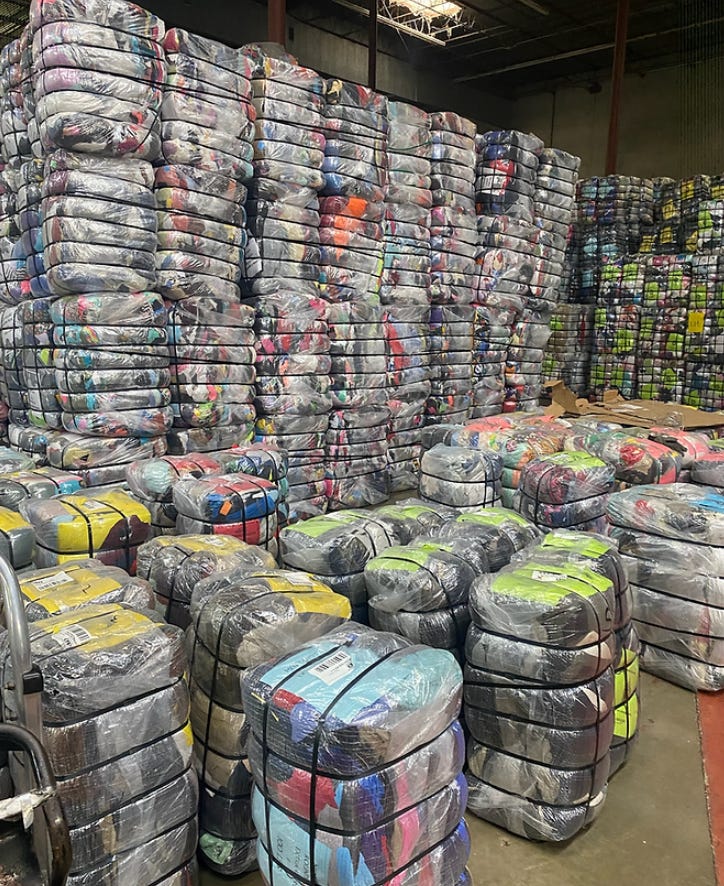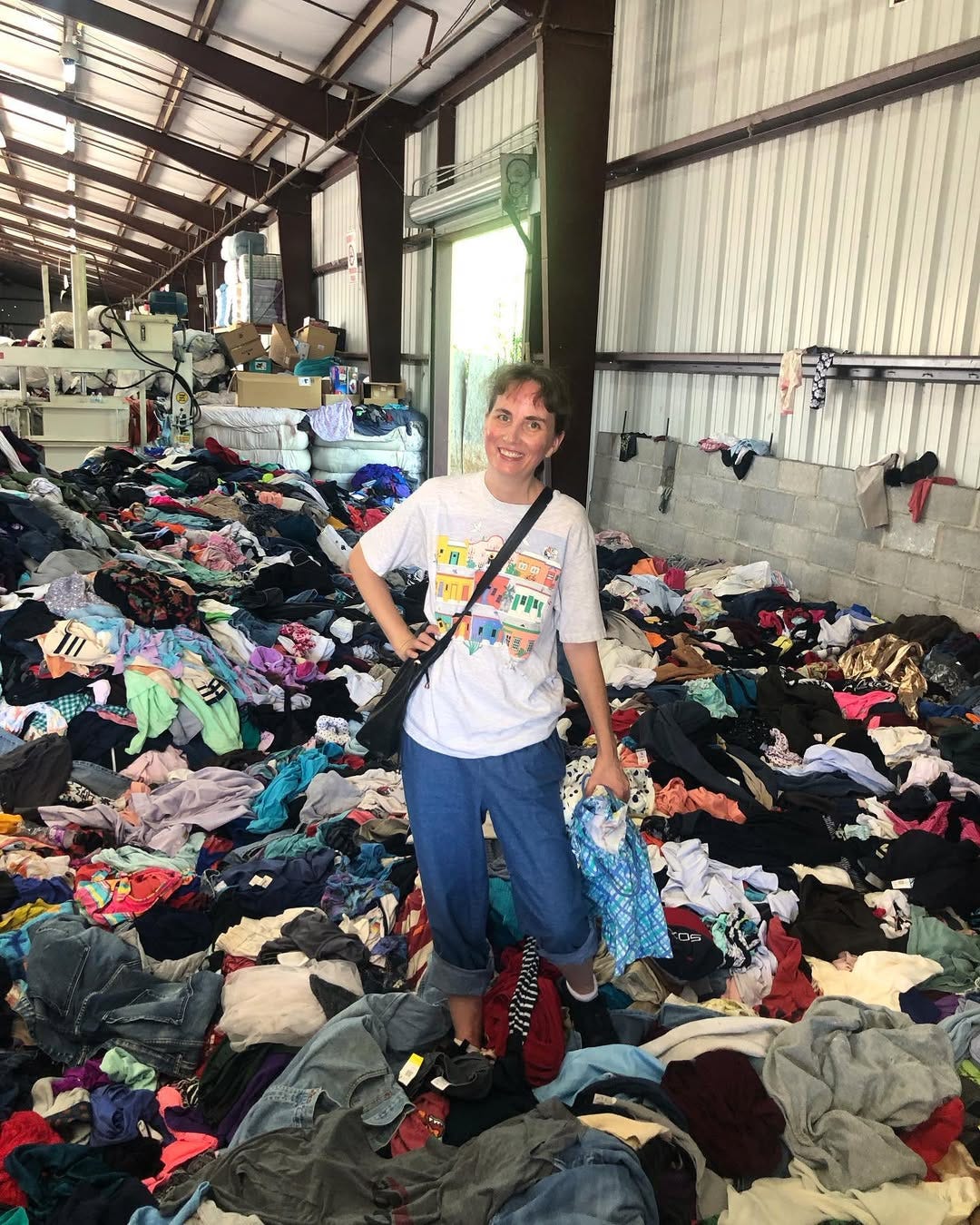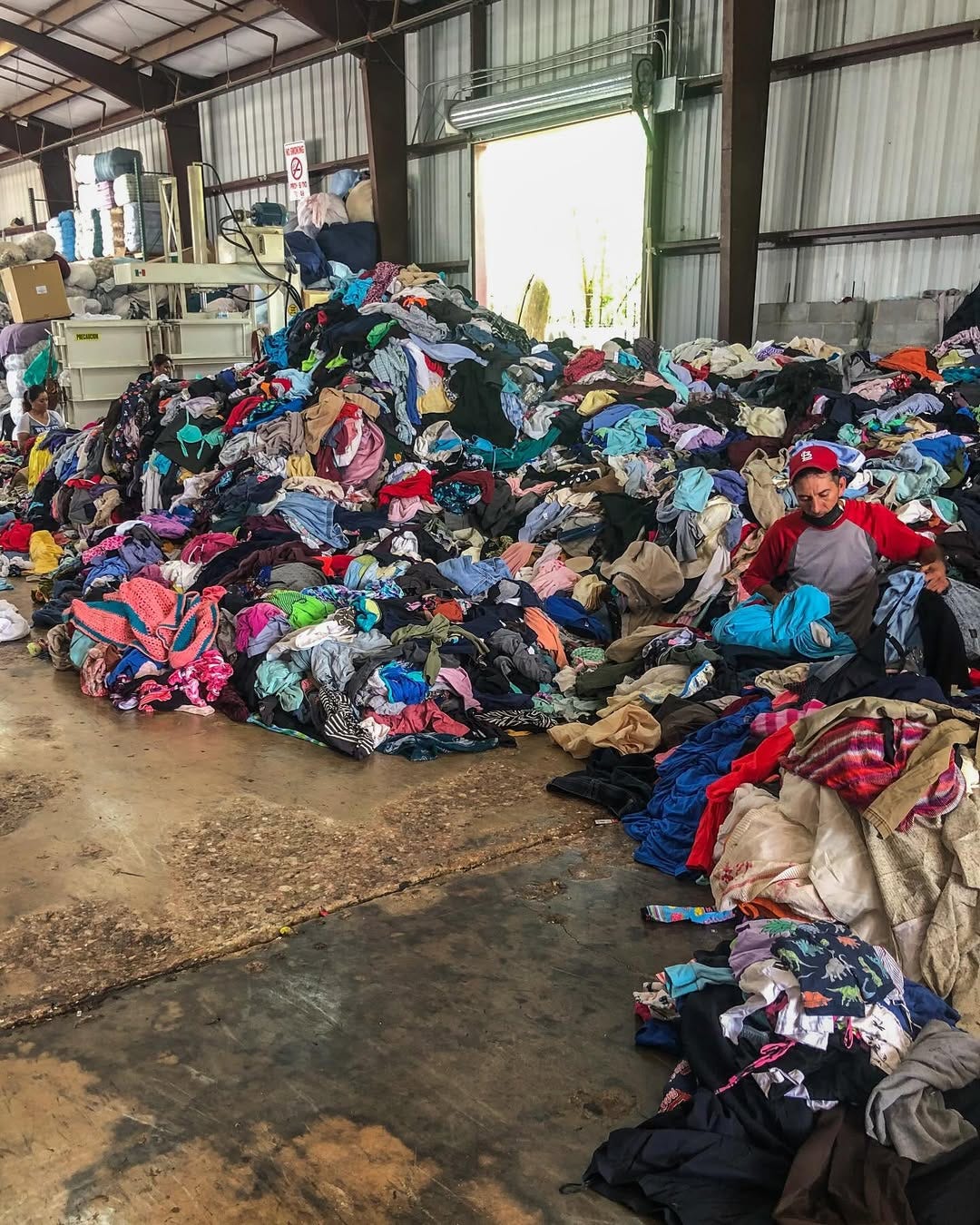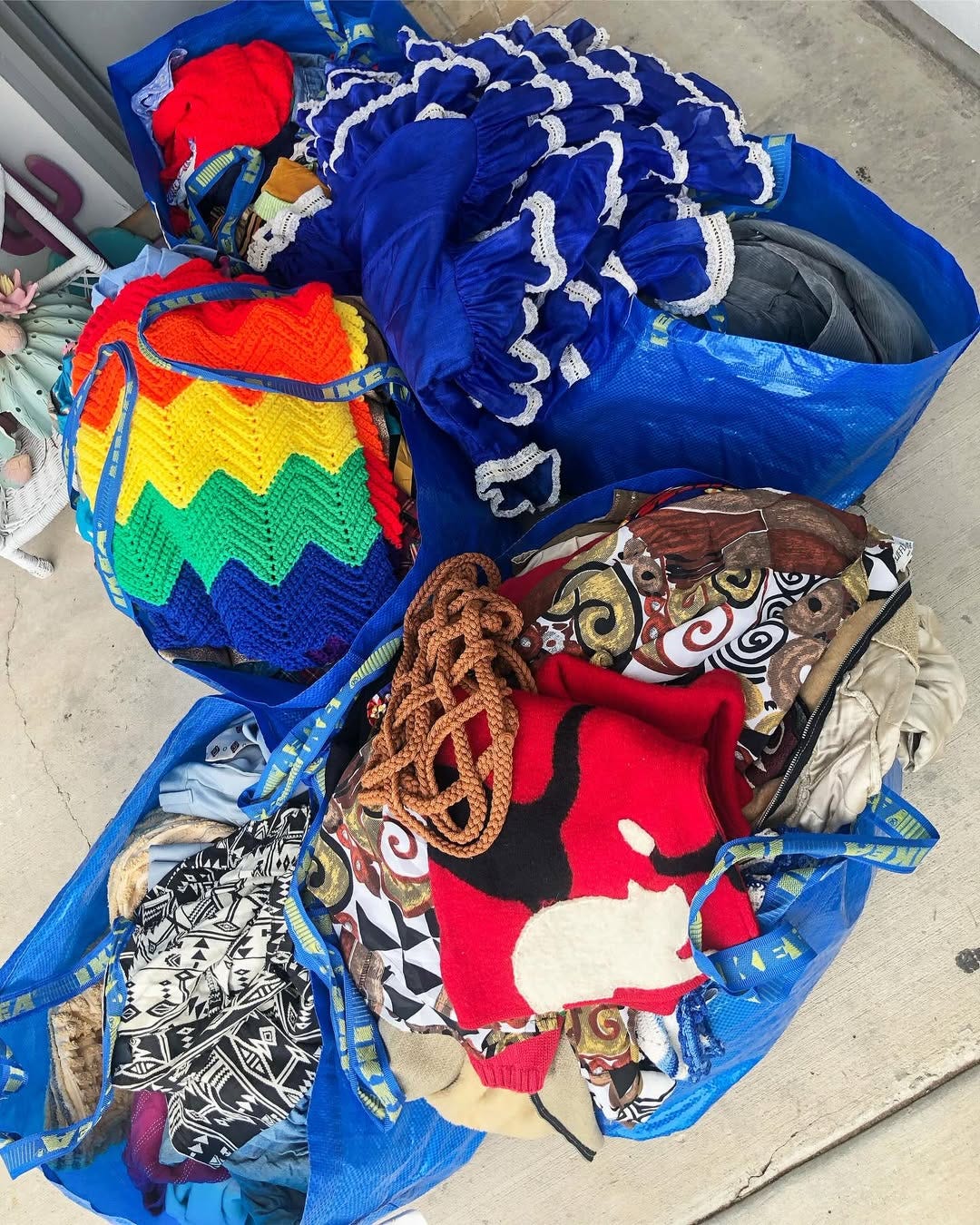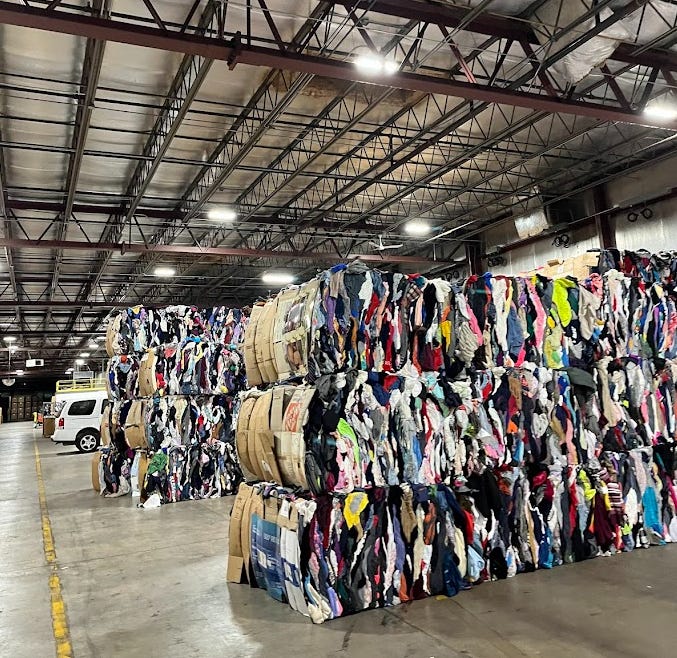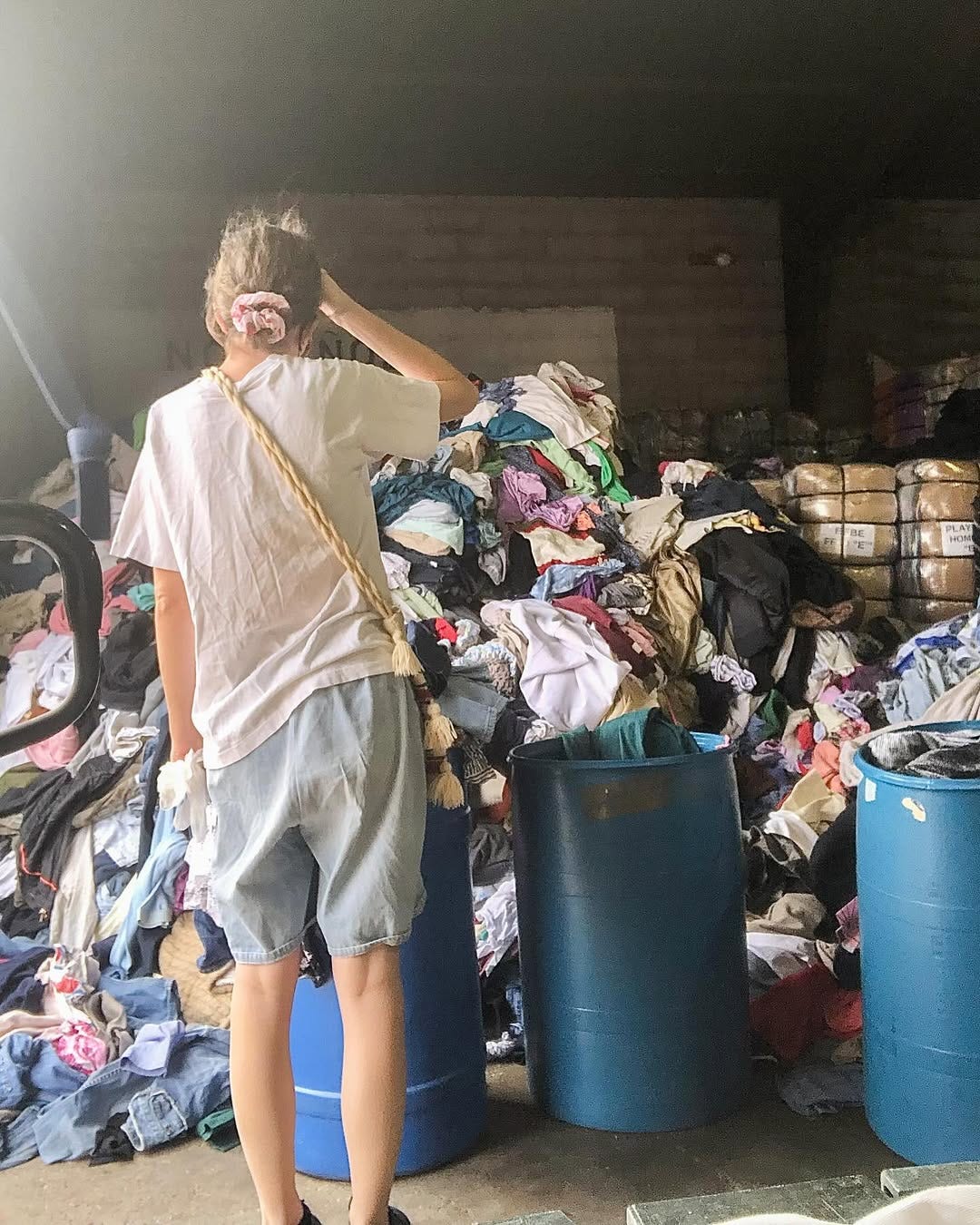Tackling Textile Waste with Community Solutions in Laredo, Texas
Guests You'll Want to Go Thrifting With: Heather Garcia, Laredo Thrifting Tours
I’m Emily Stochl, a vintage & secondhand fashion reporter 🎤 and this is Pre-Loved!
If you’re not yet a paid subscriber, here’s what you missed this month: a guide for identifying and valuing vintage (from a collector of 20-years!) 👗83 vintage Westernwear pieces inspired by the Cowboy Carter tour! 🤠 12 Fresh Spring Pre-Loved Outfits 📸 and 33 trendy and timeless East West bags under $150! 👜
Pre-Loved is an indie media platform, and your support makes it possible. Subscribe for essential vintage fashion commentary, resale industry news, and secondhand shopping guides, for less than $5 a month:
In Laredo, Texas — a U.S.-Mexico border town where warehouses overflow with discarded secondhand clothing — local resident, Heather Garcia, sees community solutions amongst the formidable waste.
Garcia’s community sits on one of the frontlines of the United States’ textile waste crisis. Each week, an overwhelming volume of secondhand clothing flows through Laredo’s forty textile sorting warehouses, creating surreal landscapes of clothing mountains stacked to ceilings.
The secondhand clothing supply chain functions a bit like a food chain: at each step, resellers skim items that can turn a maximum profit and sell — or discard — the rest downstream.
Pre-Loved readers know a lot of new clothing is produced and purchased each year: according to real closet data from Indyx, the average person is adding 59 new items to their wardrobe annually. While there is little data on how much of that is then donated or discarded, given nearly 75% of what’s in our closets was purchased in the past three years, we can extrapolate closet churn is high.
In the U.S., only about 10-20% of what is donated to charity shops is actually resold there because of high volumes of donations and low quality of goods. What happens next? The facilities in Laredo — alongside thousands of other “raghouses” across the United States — source excess inventory from Goodwill and other thrift stores nationwide (as evidenced by the original thrift store tags still attached to many of these garments), flip what they can, and move the rest downstream.
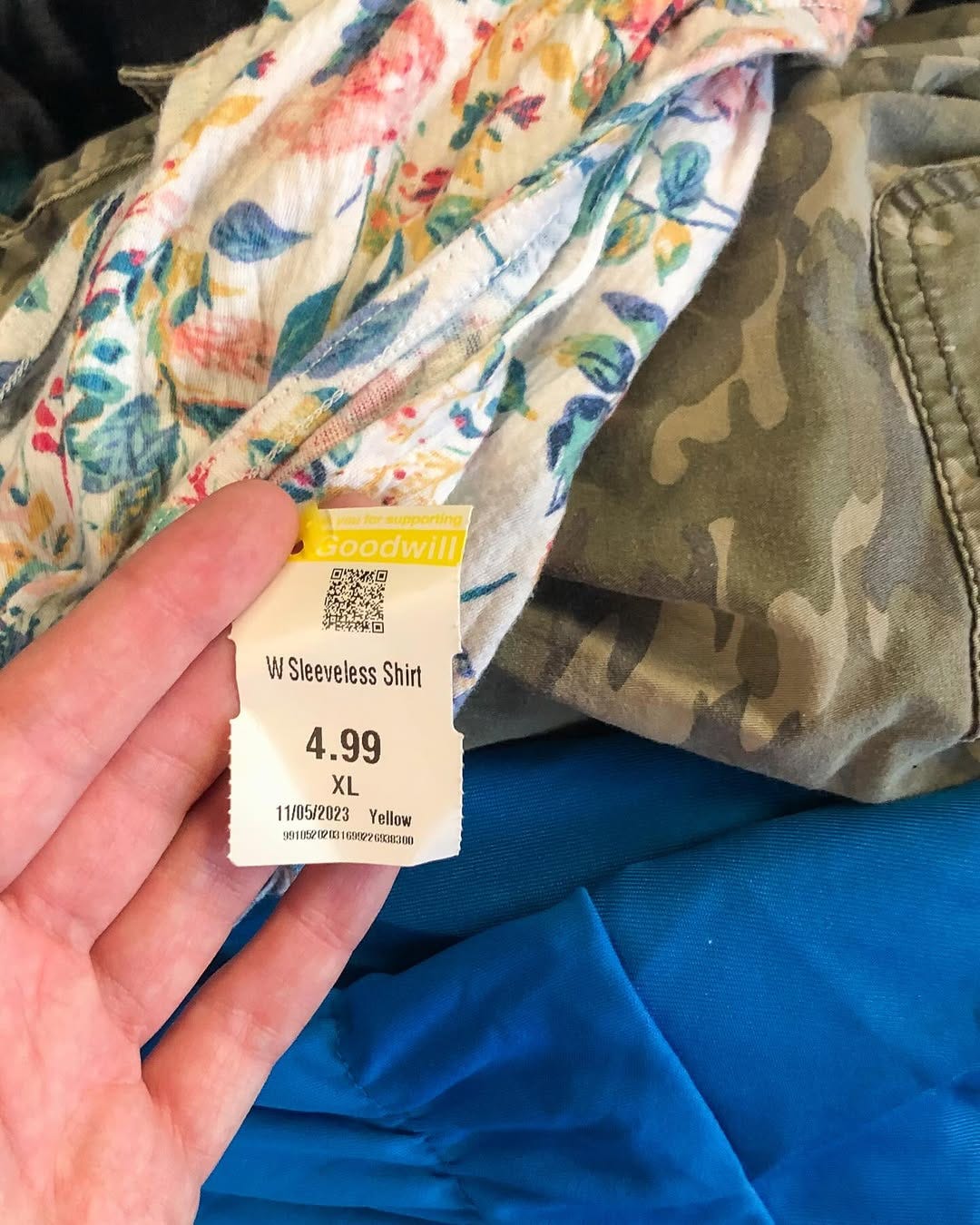
Inside these warehouses, workers and customers sort through massive textile piles searching for resalable pieces. Some items are set aside and palletized into “bales” — pressurized, plastic-wrapped containers of clothing — for resale to the next buyer, typically importers in the Global South.
🎧 Learn more about the global secondhand supply chain in Kenya, Ghana, and Chile on Pre-Loved Podcast:
And locally in Laredo, dump trucks depart these warehouses multiple times each week, hauling what isn’t resold to a buyer directly to the landfill.
But where others see only discarded waste, Heather Garcia envisions collective community solutions. Through her Laredo Thrifting Tours, she connects upcyclers, vintage dealers, and thrift shoppers to this untapped supply of pre-loved clothing — all while supporting local businesses and diverting usable items from landfill.
…Welcome to “Guests You’ll Want To Go Thrifting With!” 🎤 with Heather Garcia:
What made you want to start Laredo Thrifting Tours?
“When we first moved here — a little over two years ago now — my mother-in-law told me about these warehouses. I decided to venture out one day and saw these massive clothing piles at the warehouses.
We’d also see the dump trucks leaving, and I'd be like, oh, where's this going? I eventually noticed — because we live kind of going towards the landfill, about a mile or so away — that every time I would come back into town, I would pass these dump trucks going the opposite direction. They are loaded, like, loaded with textiles.
And this was happening weekly! There’s over 40 warehouses here in the city.
I wanted to do something about it, and I thought, well maybe I can try and get more people down here. Like upcyclers, and dealers and thrifters, to help divert the textiles. Because there's so much of it that's still usable, and I can't save it all.
I also wanted to support the local economy — these warehouses are all small businesses, too. And every time there's a thrifter that comes down here, I have a little list with the addresses of the warehouses, and also of local coffee shops, local restaurants, stuff like that.”
Why are there so many secondhand clothing warehouses in Laredo?
“I think it just has something to do with being right on the border, with the whole import-export situation. A lot of the customers come in from Mexico, and they'll be there [in the warehouses] for hours, picking through stuff to send back.”
Where do the clothes that end up in these warehouses come from?
“I do see a lot of tags from Goodwills. The warehouses buy pallets of stuff from Goodwills, and then they’ll be shipped down here. And, I also see tags from other thrift shops, and vintage pieces that still have the tags from the vintage stores that they came from. A lot of it is excess inventory that another secondhand shop tried to sell and it didn't sell, so then it went to this bulk warehouse.”
What’s the warehouse like?
“When you go inside, there's usually piles — called 'pisos,' or there’s stacks of bales. The bales are hundreds of pounds worth of clothes, basically all clothes that still need to be sorted.
And then you’ll see an open pile — a mountain, really — of clothing and textiles that people are digging through. You'll see sorters going through their own bales, too. Some of what they pick out they set aside, or they ship to importer clients in Africa or Mexico, other pieces they discard to landfill. And then, sometimes, you’ll see the guys on their forklifts coming in and out — bringing more stuff to the piles, taking stuff from the piles. It’s a whole operation!”
Are the people in the warehouse frustrated by all the waste?
“Yes, I have been able to speak with a few of them, and they are frustrated that there isn't a better solution. They hate dumping things — and they also have to pay for it! It costs them anywhere between $200-$400 per trip, to cart things to the landfill. So, they would, of course, rather get stuff sold.”
“You’ll see an open pile — a mountain, really — of clothing and textiles that people are digging through.”
Have many of them been in the business for a long time and has the industry changed?
“For a couple of them it’s a family business, and they've been at it a long time — one said about twenty years so far. But another warehouse owner I spoke to has been at it only eight months.
They have said it has changed a lot, especially since COVID-era, which changed everything. But there have also been external factors that impact how things can get moved or imported and exported, which changes their business as well. One has definitely told me that since the pandemic there has been more waste coming in, and that the overconsumption is insane.”
Do you have any idea how much goes to the warehouse each week, or how much leaves as waste?
“After one of my tours, we were actually able to follow a truck to the landfill, and they told us that one warehouse usually does two truckloads per week to the dump, and that's seven tons per load. That same truck driver, he services four other warehouses, so he mentioned about 14 truckloads per week. But, there's 40 total warehouses in Laredo, so he does like 15% of them? Maybe?
Yeah, it's insane. I just want to stop it.”
Why is your mission to get the attention of upcyclers and resellers?
“I just wish there were more people to come help because there's so much stuff. Basically, we all have different tastes in clothes, and what we want to pick up. So, while I see potential in everything, I obviously don't have room — I can't buy everything. But, especially upcyclers, there's a lot of pieces with potential.
There are pieces that are torn, or textiles like doilies and quilts, and upcyclers can make great stuff out of that! So, I wanted to get their attention and try to move more of this stuff out. I would love for thrifters to come down here from other parts of the country, and pick up things I wouldn’t normally pick up.”
Are there other resellers and vintage dealers who seem to be sourcing from the warehouses?
“I have seen some local resellers here, a lot of t-shirts bros! In terms of trendy items for them and other resellers, you see t-shirts, streetwear, Carhartt, JNCO jeans, 90s and Y2K stuff. I also see a couple of Japanese resellers as well, sourcing for vintage.
All the sellers who go through to pick stuff, they’re finding plenty. Some of the trendy or vintage stuff is also sorted out by the workers — they pick it out and separate it into piles. And the sorters will charge buyers a little more per piece for that because they’ve already set stuff aside they know customers will be interested in.
But not the “old-old” vintage, it seems like. A lot of times the old-old vintage is still in the big piles…”
And that's what you like to source, right, so you must do a lot of digging in the piles?
“Of course! Yesterday I found this really pretty crochet Afghan blanket, and it has almost like 3-D roses. Beautiful! And then I found this Edwardian tea dress... I've even found some 1930s and 40s pieces. I found a first aid bandana from the 40s, and a Chinese silk embroidered robe from the 20s — it's too fragile to wear, but I kept it.
And I've found cool vintage hats, vintage purses — even sometimes things that are kind of wrecked, but at the same time, I think they could still be fixed. And let's see, I found a cat hanger — love that! — a beautiful furry little cat children's hanger.
Like just the quirkiest stuff that you wouldn't expect. And older stuff, too. Like 70s and some 60s. I mean, I'm not finding tons every day, but you find it. It just takes digging and it's there.
I've found a crazy amount of quilts, and also the feed sack quilts that are just beautiful. There are some that I've kept, and some that I've sent off and sold.”
Have upcyclers been able to get stock from the warehouses?
“I've had a mother-daughter duo come from Dallas to find quilts and bed sheets, which they make into clothes. Ties, too! There's a bunch of ties in the warehouses. If you know people who do upcycling with ties, send them my way because I always see them! I'll also have people ask if I can source and wholesale stuff to them, which I have done before. I'll send them a box, and they’re usually pretty happy about that.”
What are your tours like? What should people expect?
“So, I do the tours seasonally — even now it’s getting hotter… I'm actually booked up through the end of April, and then I'm going to have to cut it off until, probably like September. Because it's too hot to go digging in the summer in Texas in a warehouse!
I mean, I might go, but I only stay for a little bit of time. But I don't want to be responsible for someone else's health in that way, you know. I really do care about the people who come.
I tell them to dress for the weather, and dress comfortably. Don't dress too flashy — like, I'm usually in a t-shirt and shorts. I tell them to bring reusable gloves, and bring reusable bags. I have stuff people can borrow, too.
But I tell them to be prepared to dig, because it's all about the hunt.
Oh, and you may want to brush up on some Spanish! I also do Google Translate when I need to. Also, just be kind and patient. And the warehouses are cash-only, but we do have banks here in Laredo — haha!
The warehouses don't have a minimum buy for the piles, and you don't need a resellers license or anything like that. The prices are generally from $0.25 to $1 per pound.* At one of the warehouses, you have to pay if you want them to open a certain bale, because then they have to cut it open. But that’s about it!”
*Editor’s note: Across Texas, the various Goodwill Bins charge about $1.49-$1.99 per pound for clothing. Bulk warehouse pricing means vintage dealers can achieve margins impossible elsewhere, while actively preventing usable items from landfill.
What have been some of the takeaways people have when they go on your tour?
“They're usually overwhelmed with just the amount of textile waste. One person who came in the past, she was even like, 'things are so cheap, I feel like I'm stealing.' It's really just the enormity of just the piles that leaves an impression.
I wish everyone could see this, and see how much there is. I tell my tour clients to take photos and post them, and tell other people about these warehouses and the crazy amount of stuff.”
I’m sure you’ve experienced the misconception that people are “taking all the good stuff...”
“Mm hmm, yeah, all the time. In fact, when the story about Laredo came out on Gem and I posted about it on Instagram, I got a lot of dirty responses, especially from the local t-shirt bros. People are thinking in a scarcity mindset, when, honestly, there's plenty for everybody. It’s actual ridiculous how much stuff there is.
Even the girls that were here recently on a tour, sure, they got a decent amount of stuff, but... we barely made a dent. I think we uncovered the top layer, but there's still so much stuff underneath, so many layers. I mean, I'm thinking about the truck making fourteen trips a week to the dump, so it's like, if you fill up a couple of IKEA bags in the back of a minivan, it's nowhere near how much stuff there is.
You know, I'm not trying to take business away from people. I'm trying to help community businesses, and this problem, by creating business for these warehouses who are frustrated with having to deal with — and pay for — all the waste. Helping them to be financially sustainable, too.”
“People are thinking in a scarcity mindset, when, honestly, there's plenty for everybody. It’s actual ridiculous how much stuff there is.”
Share more about why you want to get your own warehouse.
“I feel like that would be the perfect solution, getting a warehouse space, because then the other warehouses could dump to me instead of the landfill — I would incentivize them to dump to me instead with savings. We’ve talked about it, and they’re all for it. They're like, whenever you're ready, let us know.
Then I would run a pay-by-the-pound resale shop on one side of the warehouse, and set aside blankets and clothing for the human and animal shelters. And on the other side, I want to do a community-flex space, so people can have sewing and crafting classes, workshops on sustainability, or clothing swaps.
Another need I've heard is, there's a farmers market here in town, but several vendors can't afford a brick-and-mortar because of the cost of rent. But, maybe in a warehouse, they could set up a little booth — like a mini-mall, but it's all local businesses and reusable product.
If I get stuff that can’t be used at all, I would make sure it's either recycled or trashed responsibly. There are a lot of companies that have ways of reusing unusable textiles, by breaking them down into insulation and things like that.”
Heather has formed her nonprofit, Laredo Thrift and Center for Creative Reuse, and is currently raising money via GoFundMe to secure a warehouse space.
“I want to be there for my community," she says, embodying the spirit of someone who sees potential — both in clothing and in collective solutions.
In truth, Laredo is a microcosm of a global textile waste problem. Whether you're a reseller looking for inventory, an upcycler seeking materials, or someone who cares about reducing textile waste, let Laredo’s story be a reminder that you, too, can be part of the solution globally and locally.
Thanks for reading and supporting Pre-Loved! If you took something away from this letter, please share with a friend! ♻️
Find me across the internet on Instagram, TikTok, and Threads! 💛 - Emily
PS: Got a tip for Pre-Loved? 💌 Launching a new resale innovation? Solving a piece of the circular fashion puzzle? Have a buzzy piece of vintage news you want readers to know about? Put a tip in my inbox: prelovedpodpr@gmail.com. 📥







